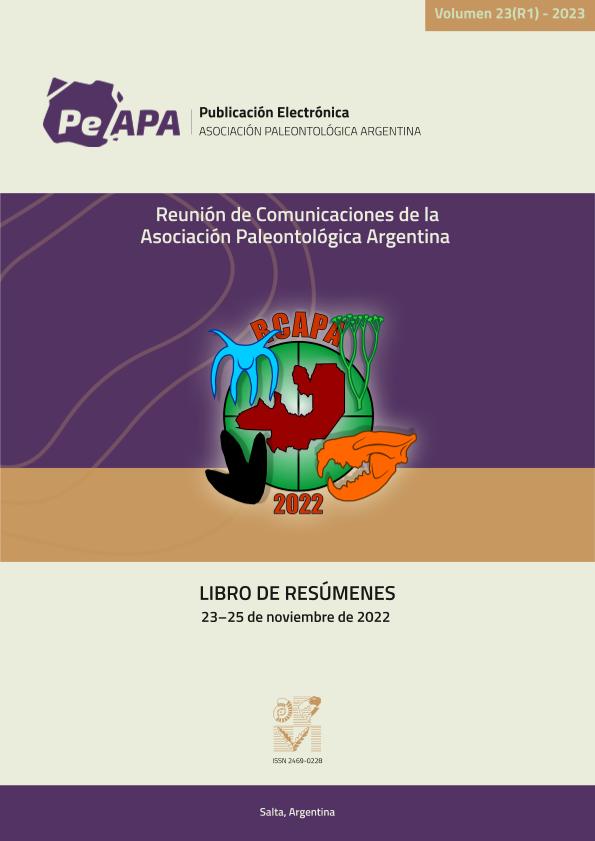Mostrar el registro sencillo del ítem
dc.contributor.author
Martini, Gastón Andrés

dc.contributor.author
Degrange, Federico Javier

dc.contributor.author
Gonzalez Ruiz, Laureano Raul

dc.date.available
2024-02-28T15:35:26Z
dc.date.issued
2023
dc.identifier.citation
The inner ear of Propalaehoplophorus Ameghino (Xenarthra, Cingulata, Glyptodontidae); Reunión de Comunicaciones de la Asociación Paleontológica Argentina; Salta; Argentina; 2022; 99-99
dc.identifier.issn
2469-0228
dc.identifier.uri
http://hdl.handle.net/11336/228844
dc.description.abstract
The anatomy of the extant xenarthran inner ear has shown a correlation between the semicircular canals with functional aspects related to locomotion, as well as their phylogenetic history. Since so far, studies of the inner ear of extinct xenarthrans are known for folivorans, pampathers and some glyptodonts. Yet, the inner ear of "Propalaehoplophorinae" glyptodonts (the oldest glyptodonts which cranium is known) remains unknown. The aim of this study is to describe the bony labyrinth of the inner ear of the glyptodont Propalaehoplophorus Ameghino (YPM-VPPU, Yale Peabody Museum, 15007), from the Santa Cruz Formation (early Miocene) of Patagonia (Argentina), which was observed using micro-computed tomography, and subsequently reconstructed in 3D. The bony labyrinth (i.e., cochlea and semicircular canals) presents a general gracile appearance with small and relatively thin semicircular canals, including a proportionally long and slim common crus, between the anterior and posterior semicircular canals. As in other glyptodonts (e.g., Glyptodon, Doedicurus, Panochthus, and Pseudoplohophorus) and the armadillo Chlamyphorus, a reduced secondary common crus, between the posterior portion of the lateral semicircular canal and the ventral one of the posterior semicircular canal, is present. Ampullae are robust. As in other glyptodonts, the cochlea has less than two coils, with an appreciable and large space between the poorly coiled proximal section from the more tightly coiled distal one. The secondary bony (basilar) lamina sulcus of the cochlea is indistinct or not observable in other glyptodonts (previously mentioned), but it is present in Propalaehoplophorus with a reduced extent. This preliminary description, shows that the inner ear of Propalaehoplophorus is similar to the inner ear of aforementioned glyptodonts and most extant armadillos (e.g., Dasypus, Chaetophractus and Zaedyus, among others) (particularly with Chlamyphorus). Even though some variability is observed among glyptodonts, which indicate that the Miocene glyptodont Propalaehoplophorus would be within the range of slow to medium-slow agility levels, along with large Pleistocene glyptodonts (e.g., Glyptodon, Doedicurus, Panochthus, and Pseudoplohophorus) and most extant armadillos (previously mentioned). Moreover, the results provided here would serve as a basis for future anatomical and functional studies based on auditory and equilibrium abilities in these Miocene glyptodonts, as to unravel phylogenetic implications, hearing patterns and locomotion evolution across Cingulata.
dc.format
application/pdf
dc.language.iso
eng
dc.publisher
Asociación Paleontológica Argentina

dc.rights
info:eu-repo/semantics/openAccess
dc.rights.uri
https://creativecommons.org/licenses/by-nd/2.5/ar/
dc.subject
INNER EAR
dc.subject
GLYPTODONTS
dc.subject
ANATOMY
dc.subject
FORMACION SANTA CRUZ
dc.subject.classification
Paleontología

dc.subject.classification
Ciencias de la Tierra y relacionadas con el Medio Ambiente

dc.subject.classification
CIENCIAS NATURALES Y EXACTAS

dc.title
The inner ear of Propalaehoplophorus Ameghino (Xenarthra, Cingulata, Glyptodontidae)
dc.type
info:eu-repo/semantics/publishedVersion
dc.type
info:eu-repo/semantics/conferenceObject
dc.type
info:ar-repo/semantics/documento de conferencia
dc.date.updated
2024-01-30T12:10:28Z
dc.journal.volume
23
dc.journal.number
1
dc.journal.pagination
99-99
dc.journal.pais
Argentina

dc.journal.ciudad
Ciudad Autónoma de Buenos Aires
dc.description.fil
Fil: Martini, Gastón Andrés. Consejo Nacional de Investigaciones Científicas y Técnicas. Centro Científico Tecnológico Conicet - Patagonia Norte. Centro de Investigación Esquel de Montaña y Estepa Patagónica. Universidad Nacional de la Patagonia "San Juan Bosco". Centro de Investigación Esquel de Montaña y Estepa Patagónica; Argentina
dc.description.fil
Fil: Degrange, Federico Javier. Consejo Nacional de Investigaciones Científicas y Técnicas. Centro Científico Tecnológico Conicet - Córdoba. Centro de Investigaciones en Ciencias de la Tierra. Universidad Nacional de Córdoba. Facultad de Ciencias Exactas Físicas y Naturales. Centro de Investigaciones en Ciencias de la Tierra; Argentina
dc.description.fil
Fil: Gonzalez Ruiz, Laureano Raul. Consejo Nacional de Investigaciones Científicas y Técnicas. Centro Científico Tecnológico Conicet - Patagonia Norte. Centro de Investigación Esquel de Montaña y Estepa Patagónica. Universidad Nacional de la Patagonia "San Juan Bosco". Centro de Investigación Esquel de Montaña y Estepa Patagónica; Argentina
dc.relation.alternativeid
info:eu-repo/semantics/altIdentifier/url/https://www.peapaleontologica.org.ar/index.php/peapa/article/view/462
dc.relation.alternativeid
info:eu-repo/semantics/altIdentifier/doi/http://dx.doi.org/10.5710/PEAPA.23.03.2023.462
dc.conicet.rol
Autor

dc.conicet.rol
Autor

dc.conicet.rol
Autor

dc.coverage
Nacional
dc.type.subtype
Reunión
dc.description.nombreEvento
Reunión de Comunicaciones de la Asociación Paleontológica Argentina
dc.date.evento
2022-11-23
dc.description.ciudadEvento
Salta
dc.description.paisEvento
Argentina

dc.type.publicacion
Journal
dc.description.institucionOrganizadora
Asociación Paleontológica Argentina
dc.description.institucionOrganizadora
Consejo Nacional de Investigaciones Científicas y Técnicas. Instituto de Bio y Geociencias del Noroeste Argentino
dc.description.institucionOrganizadora
Universidad Nacional de Salta. Facultad de Ciencias Naturales. Instituto para el Estudio de la Biodiversidad de Invertebrados
dc.source.revista
Publicación Electrónica de la Asociación Paleontológica Argentina
dc.date.eventoHasta
2022-11-25
dc.type
Reunión
Archivos asociados
